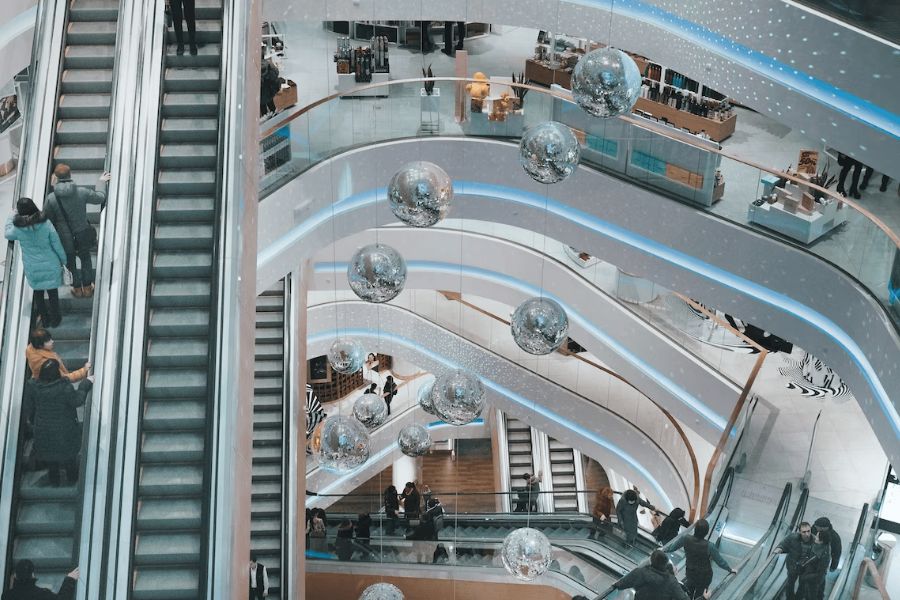Recently, the rapid emergence of e-commerce as well as the COVID-19 pandemic are threatening the survival of brick-and-mortar stores. As it is a common question that everyone is having in mind nowadays, in today’s article, we will find out every clue we need to answer the question: Are brick-and-mortar stores outdated?
Retail Apocalypse is lingering
What Retail Apocalypse is and Why it happens
Retail Apocalypse refers to the closing of numerous brick-and-mortar retail stores, especially those of large chains worldwide, starting around 2010 and continuing onward. While many people point their finger on the unstoppable e-commerce growth, there are actually several factors moving behind the scene when big retailers are collapsing.
- The rapid growth of e-commerce (electronic commerce)
A lot of people blame e-commerce as the main reason leading to the retail apocalypse. It is a fact that e-commerce has been reshaping consumers’ shopping habits as there is a trend of doing shopping from home through online platforms. Not to mention that e-commerce is very competitive in terms of price and promotions.
According to Adobe Digital Insights, during the holidays, the sales volume for e-commerce was reported as increasing by 11% for 2016 compared with 2015. They are such considerable numbers in comparison with retail stores which only witnessed an increase of 1.6% in sales. There are even several physical department stores that experienced a 4.8% decline in sales.
- Oversupply of malls
Cowen Research stated that between 1970 and 2015, the growth rate of malls in the United States is as twice as the growth rate of the population. The investment in malls was artificially accelerated when the United States Congress introduced accelerated depreciation into the tax code. However, despite the construction of new malls, mall visits declined by 50% between 2010 and 2013 with further declines reported in each successive year.
- Shrinking middle-class
Middle-class customers really matter to retail stores, such as Macy’s and Sears, since this market segment is their biggest spenders. Sadly, there are larger national chains that are able to sell at lower margins.
This makes middle-class people prefer spending their money on cheaper stores. Eventually, independent retailers, particularly in the rural areas, lost their customers and closed their business.
- Experience economy
The experience economy, also known as restaurant renaissance, is defined as “an economy in which many goods or services are sold by emphasizing the effect they can have on people’s lives” by Cambridge Dictionary. It indicates the customers’ preference shifting from buying tangible and material goods like clothing to purchasing services like dining out or traveling.
- Poor retail management
Poor retail management usually results from bad inventory management. The lack of accurate inventory control creates underperforming and out-of-stock merchandise, causing a poor shopping experience for customers. This makes customers prefer to shop online which has better stock availability.
Additionally, improper inventory management leads to a low inventory return of investment rate because of a high chance of dead stock staying forever in the warehouses. Moreover, unawareness of dead stock, slow-moving stock, and best-sellers prevents business owners from making insightful and timely decisions to optimize inventory return on investment.
- COVID-19 pandemic
Last but not least, COVID-19 is putting human interaction at the risk of being infected. Therefore, many retailers have to shut down their physical stores due to non-pharmaceutical interventions issued with the purpose to mitigate the pandemic.
As a result, online shopping has been booming during the lockdowns. Most of the major e-commerce retailers were classified as essential businesses and were not required to shut down. Buyers stated that they would buy products such as food and drinks, hygiene care products, household cleaning, clothing, etc. through online platforms rather than in person due to COVID-19.
Retail Apocalypse statistics
- In 2019, more than 9,300 stores were closed as the retail apocalypse.
- Coresight Research projects that a record 25,000 stores will close in 2020 – up from its pre-pandemic estimate of 8,000.
- The retail trade boasts 146,400 fewer jobs than previously thought, a 0.9% drop in 2020.
- According to Forbes, by November 12, 2020, the number of store closures so far is 14,463. The data is updated frequently.
- COVID-19 can change the shopping behavior permanently: according to O2 Business and Retail Economics, 44% of surveyed consumers stated that they had no intention to ever go back to offline shopping.
Brick-and-mortar store isn’t dead, it’s evolving
This was stated by Ken Morris, principal, and Perry Kramer, vice president and practice lead at Boston Retail Partners. “Stores are no longer stores, they are distribution points for products,” says Morris. It’s going to be critical for retailers to offer their customers more than just a shopping opportunity, but an experience. And in fact, there are some retailers understanding that and leveraging technology, especially a POS solution, to innovate their businesses.
“We don’t build retail stores”, says Restoration Hardware CEO Gary Friedman. Restoration Hardware has showroom stores but is not selling anything there. The showrooms are meant to provide inspiration and style guidance as it can be described as a giant 3D real-time catalog.
Apple is an excellent example of a retailer that has done a good job of providing customers with an experience of this new convenience economy. Walking into Apple stores, customers can try new products, get the product demonstration, and ask questions of knowledgeable sales associates. And they are ubiquitous as you can find them in any mall.
At CaliBurger in Pasadena, California, customers can smile at the camera in the ordering kiosk to open their loyalty account, place their order on the touchpad and then pay with a second smile for the camera. For now, customers still need to enter the three-digit CVV security code to process the transaction. And CaliBurger is trying to eliminate the use of the security code with further technological innovation in the POS solution in the future.
What do businesses need to do?
So, it’s all about customer experience in this era when technology is rapidly growing. And the secret behind all of the success of the retail apocalypse survivors is that they adapt and stay competitive with the help of technology, specifically a POS solution.
Create an omnichannel shopping experience
One of the most competitive strengths of brick-and-mortar stores is the ability to provide customers with an in-person product experience. A POS solution integrating this experience with online channels by leveraging technology is what separates thriving brick-and-mortar retailers and the rest.
This has been called the omnichannel experience. Today’s consumers do not distinguish between buying online and in person, or between shopping and entertainment. Here are some useful takeaways for an omnichannel experience for customers.
- Click-and-Collect: Some people describe this as the hybrid of online and offline shopping experiences. In fact, many brick-and-mortar retailers can boost their sales by offering click-and-collect options for customers as many people love it. It offers the convenience of buying online, plus the instant gratification of walking out of a store with a purchase. Particularly, during the COVID-19 pandemic, click-and-collect makes even more sense for customers as it helps reduce time spent in-store. Moreover, it can actually enhance in-store sales as well. According to the International Council of Shopping Centers, 69% of click and collect customers purchased additional items while they were picking up what they’d ordered online.
- Artificial Intelligence (AI): The advantage online retailers have is that they can collect valuable consumer data. Most traditional retailers don’t capture information when a consumer enters a store, not to mention leverage this information to serve customers more efficiently. Lately, with help from AI, brick-and-mortar stores now can not only gather customer databases but also make product recommendations and even predict customers’ preferences based on AI facial recognition.
Personalized product recommendations
- Consumer apps: An app can also bridge digital and in-store, thanks to location-based services, stock tracking, loyalty reward programs, etc. Retailers can integrate handy features into their mobile app, such as self-check-out, virtual aisles, in-store gamification, augmented commerce, etc. Brand experience extensions on the mobile app will include additional features that cause engagement when away from the physical stores through features such as a virtual fitting room and product test suites, social sharing and recommendations, influencer marketing, etc.
Have better control over your retail management
A POS solution ensuring a proper inventory management system is critical to the success of every business. It’s fruitful for retailers to use an inventory management system to improve items management in their warehouses and stores to avoid running out-of-stock or overselling. Even better, some retailers integrate their inventory management system with the point-of-sale (POS) system for a better shopping experience.
The inventory management system in POS comes in handy as it helps
- Ensure synchronization among stores and warehouses
- Maximize your inventory’s ROI by identifying dead stock, slow-moving stock and best-sellers,
- Have your inventory in check always
- Make better inventory management plans with reports.
Final thoughts,
As the retail apocalypse is dragging on, plus the breaking out of the COVID-19 pandemic that doesn’t seem to end soon, the survival of brick-and-mortar stores are still at risk. In the meantime, it is high time traditional brick-and-mortar stores innovated themselves to be able to not only survive but more than that, continue thriving in this particularly hard period of time. And there is one way to do it – adopting technology, especially a POS.
At ConnectPOS, we are proud to have all the sources and abilities to provide you with a great POS solution for your business’s success. Our cloud-based POS system is feature-rich with some worth mentioning features:
- Click-and-collect
- AI facial recognition
- PWA (progressive web app) consumer app
- Multi-store and multi-warehouse inventory management
Contact us today, or book your 14-day free trial to experience our globally standard service!
►►► See our products: Magento POS, BigCommerce POS, Shopify POS, Woocommerce POS, NetSuite POS, Commercetools POS, Customize POS, Customer Experience Solution and Next-Gen POS




